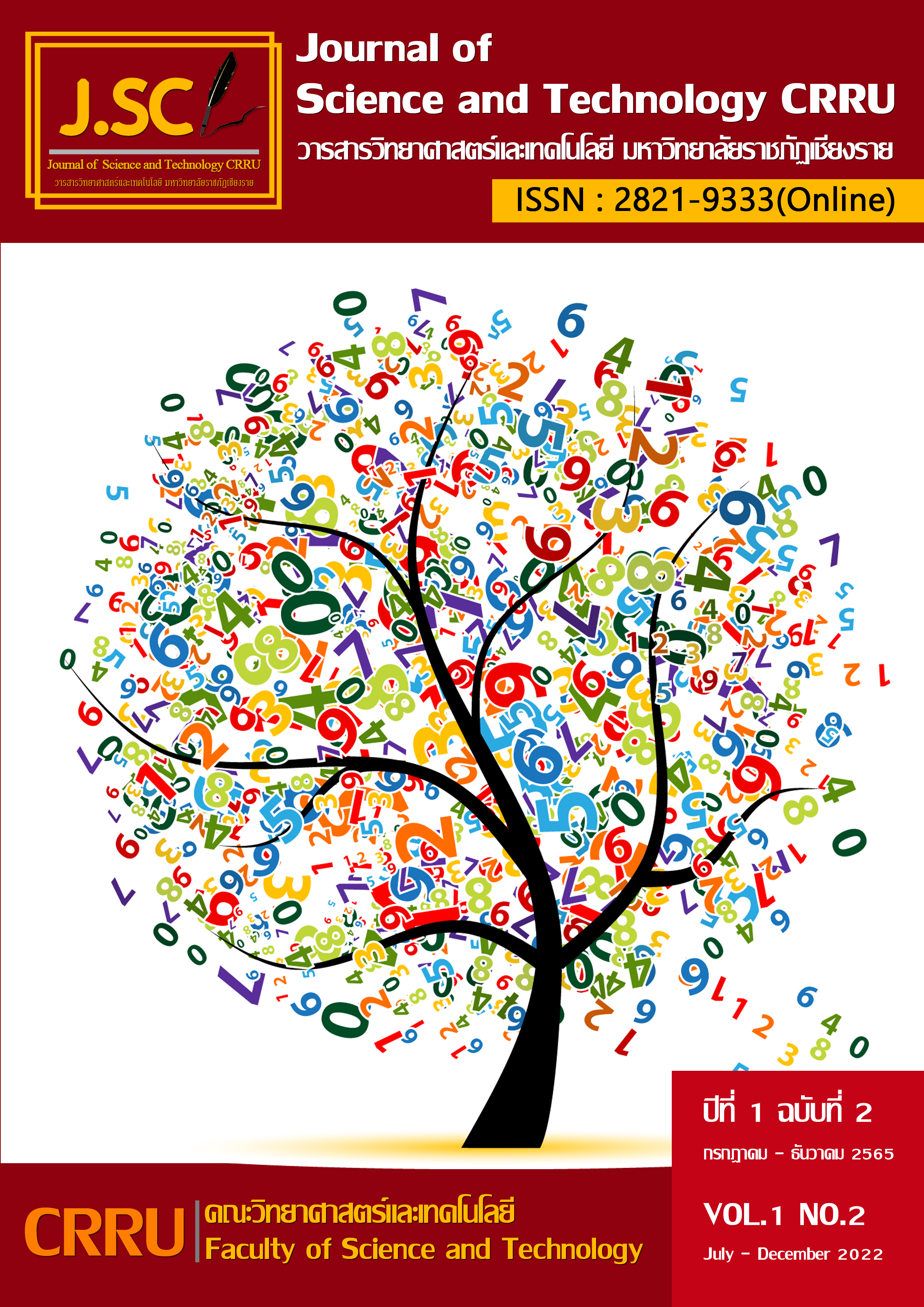Genetic diversity of bamboo using SSR markers
Main Article Content
Abstract
The bamboo is Gramineae commercially important crop of Thailand and have similar externalities. Therefore, it is necessary to use an instrument that is accurate to classify. The SSR marker is an interesting and accurate tool.Therefore, this research is to study the genetic diversity of bamboo in Phetchabun Province, such as Bambusa Bambos, Giganochloa albociliata, Bambusa vulgaris, Bambusa tulda, Dendrocalamus strictus., Bambusa vulgaris., Bambusa oldhamii., Bambusa nutans., Dendrocalamus giganteus, Bambusa vulgaris, Bambusa blumeana, Neohouzeaus mekongensis and Gigintochloa compressa by using three SSRs markers. From the increase in DNA content using the Polymerase Chain Reaction, 10 polymorphisms were shown with a genetic similarity. Coefficient was between 0.55-1.00. It can be divided into two groups clearly and indicating that the SSR molecular markers were able to identify the genetic diversity of thirteen bamboo species.
Article Details

This work is licensed under a Creative Commons Attribution-NonCommercial-NoDerivatives 4.0 International License.
Journal of TCI is licensed under a Creative Commons Attribution-NonCommercial-NoDerivatives 4.0 International (CC BY-NC-ND 4.0)
References
สุทัศน์ เดชวิสิทธิ์. (2544). การปลูกไม้ไผ่. (พิมพ์ครั้งที่ 2). นนทบุรี: สำนักพิมพ์เกษตรสาส์น.
รุ่งรัตน์ ศรีนวกุล. (2550). การให้บริการปรึกษาแนะนำเชิงลึกโรงงานอุตสาหกรรมเครื่องเรือนไม้ไผ่. งานศึกษาวิจัย ส่วนพัฒนาอุตสาหกรรมเครื่องเรือน สำนักพัฒนาอุตสาหกรรมรายสาขา กรมส่งเสริมอุตสาหกรรม.
สำนักฟื้นฟูและพัฒนาพื้นที่อนุรักษ์. (2555). การสำรวจไม้ไผ่ของประเทศไทย(Bamboo Inventory in Thailand พ.ศ. 2552. สืบค้นจาก http://www.dnp.go.th/inventory/download/รายงานไผ่ทั่วประเทศ.pdf. (สืบค้นเมื่อวันที่ 7 ตุลาคม 2564).
สรพงศ์ เบญจศรี. (2554). เครื่องหมายโมเลกุลสำหรับการปรับปรุงพันธุ์พืช. วารสารวิทยาศาสตร์ มข., 2554(39), 350-363.
จินตนา อิงคนินันท์. (2550). เอกสารประกอบคำสอนวิชาการวิเคราะห์ลายพิมพ์ดีเอ็นเอ. มหาวิทยาลัยเกษตรศาสตร์ วิทยาเขตกำแพงแสน, นครปฐม.
Kitamura, K., Yanazawa, M., Sugiyama, N., Miura, H., Iizuka-Kogo, A., Kusaka, M., Omichi, K., Suzuki, R., Kato-Fukui, Y., Kamiirisa, K., et al. (2002). Mutation of ARX causes abnormal development of forebrain and testes in mice and X-linked lissencephaly with abnormal genitalia in humans. Nat Genet., 32(3), 359-369.
Abreu, A. G., Grombone-Guaratini, M. T., Monteiro, M., Pinheiro, J. B., Tombolato, A. F.C., & Zucchi, M. I. (2011). Development of microsatellite markers for Aulonemia aristulata (Poaceae) and cross-amplification in other bamboo species. American journal of botany, 98(4), e90-e92.
สุจิตรา จางตระกูล (2553). การศึกษาความหลากหลายทางพันธุกรรมของไผ่ซางนวล (Dendrocalamus membranaceus) ในประเทศไทยโดยใช้Microsatellite Markers.กรุงเทพฯ: กรมอุทยานแห่งชาติสัตว์ป่าและพันธุ์พืช.
อนุชสา บุญชาญ และ กิตติพัฒน์ อุโฆษกิจ. (2555). การศึกษาความหลากหลายทางพันธุกรรมของไผ่ในประเทศไทยโดยใช้เครื่องหมายโมเลกุลชนิด EST-SSR จากอ้อย. วารสารวิทยาศาสตร์และเทคโนโลยี, 20(1), 37-48.
หนูเดือน เมืองแสน ฐิติพร มะชิโกวา และ วปัญจมา จรรยาเลิศอดุล. (2560). การประเมินความหลากหลายทางพันธุกรรมของทานตะวันโดยเครื่องหมายโมเลกุลชนิดเอสเอสอาร์และอาร์เอพีดี. Suranaree University of Technology Intellectual Repository. สืบค้นจาก http://sutir.sut.ac.th:8080/jspui/bitstream/123456789/7053/2/Fulltext.pdf. (สืบค้นเมื่อวันที่ 10 มกราคม 2565).
Chakravarthi, B.K., & Naravaneni, R. (2006). SSR marker based DNA fingerprinting and diversity study in rice (Oryza sativa L). Afr. J. Biotechnol., 5, 684-688.
สุรเชษฐ เอี่ยมสำอาง และ สุมาลี พิมพันธ์. (2563). ความหลากหลายทางพันธุกรรมของกาแฟ (Coffea arabica) ในพื้นที่อำเภอเขาค้อ จังหวัดเพชรบูรณ์ โดยเทคนิคเครื่องหมายโมเลกุลเอสเอสอาร์ (Genetic Diversity in Coffee (Coffea arabica) from Khao Kho District Phetchabun Province by SSR Marker Technique). แก่นเกษตร, 48(ฉบับพิเศษ 1), 515-524.
Kitamura, K., Saitoh, T., Matsuo, A., & Suyama, Y. (2009). Development of microsatellite markers for the dwarf bamboo species Sasa cernua and Sasa kurilensis (Poaceae) in northern Japan. Molecular Ecology Resources, 9(6), 1470-1472.


